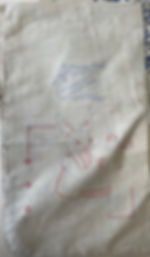Today's social media Artifact post featured a glimpse of a unique bean sack from Michigan Bean Company's Jack Rabbit brand of beans, but there is much more to this story.

The Jack Rabbit Bean Bunny is a relic of a portion of Saginaw’s past dedicated to agriculture and its impact on the community. The history behind the iconic brand is one of intrigue and connections can be made to a larger story of America’s past. Originally in the nineteenth century, agricultural products were sold in wooden barrels or tins. This shipping process changed with the invention of the sewing machine. Cotton sacks with the mill’s name printed on them became commonplace in households. In 1847, Henry Chase began to utilize cotton and other materials, such as burlap, when he founded Chase Bag Company in Boston. His business grew as they expanded across the United States in the form of factories and sales offices. Factories close to Michigan were the ones located in Chagrin Falls, OH and Toledo, OH. There was also a sales office located in Detroit, Michigan.

The early to mid-twentieth century saw the popularity of cotton bags grow as families suffered economic hardship. Cotton bags, such as the Jack Rabbit bean bag pictured, would have been recycled for their fabric to fulfill the family’s needs of cotton material. These types of sacks became known as commodity bags, and were commonly white or off-white in color, such as that pictured. Chase Bag Company was one manufacturer of machine-sewn commodity bags. As more women began to purchase the bags, companies began to shift their marketing to the new customers. Colors and patterns were added to the bags, booklets were published by the Textile Manufacturer’s Association with pattern instructions, and needlework patterns were printed onto the back of bags. Found on the back of the 5lb Jack Rabbit Hand-Picked Navy Beans sack is a needlework activity marketed to children. The pattern features a mother rabbit and a child rabbit with text that reads “To Occupy Little Fingers. Work Design in various color threads. Wash in usual manner. A Chase Design.”

Blog Post & Research By: Katey Vanscoy, Castle Museum Collections Assistant
Sources:
Adrosko, Rita, "THE FASHION'S IN THE BAG: Recycling feed, flour, and sugar sacks during the middle decades of the 20th century" (1992). Textile Society of America Symposium Proceedings. 557. https://digitalcommons.unl.edu/tsaconf/557
Lee, Heather Vaughan. “Make Do: Feed-Sack Fashion in the First Half of the Twentieth Century.” PieceWork, November 11, 2020. https://pieceworkmagazine.com/make-do-feed-sack-fashion-in-the-first-half-of-the-twentieth-century/.
(LSU), Louisiana State University. “Converting Commodity Bags: Recycling Circa 1940.” LSU Textile and Costume Museum . Accessed June 2, 2023.
https://www.lsu.edu/textilemuseum/exhibitions/converting-commodity-bags.php.
“Sewing With Cotton Bags .” Yellowzeppelin. Accessed June 2, 2023. http://www.yellowzeppelin.net/Sewing%20with%20Cotton%20Bags.html.
